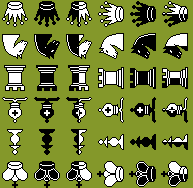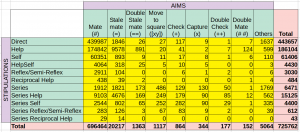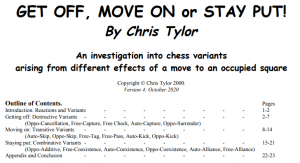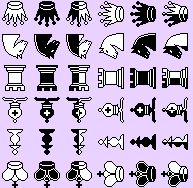 Fairy Classification: preliminary questions
Fairy Classification: preliminary questions
If the project of creating some better database of fairy elements might succeed? If we’re ready to jump into it? Who would be ready to join the team? What is the order and what’s the freedom? And what’s is the main purpose of this database?
Let me quote the words of Chris Tylor’s comment which has just appeared: “I now propose that we go back to basics and make the overall aim of our new database not so much to produce order as to give light – to show users new properties and applications of a range of fairy elements, together with the way in which they relate to other elements (or perhaps stand alone), and maybe in the process point users to ways in which new advances might be made.” – Agree!
Let’s summarize the most important ideas from about 80 comments to Fairy Statistics post:
1. Statistics about fairy elements
We have about 2700 of fairy pieces and conditions ( in Excel file for download | or in PDF (51 page) for watching). And the list of 21 most used fairy pieces/conditions is updated with inventors’ names thanks to your help in the comment (specially by Kjell Widlert and Marjan Kovačević).
| No. |
Name
(WinChloe, French) |
Name
(Popeye, English) |
Number of problems |
Inventor |
year of invention |
| 1 |
Sauterelle |
Grasshopper |
14073 |
T.R.Dawson |
1913 |
| 2 |
Circé |
Circe |
11896 |
Pierre Monréal |
1967 |
| 3 |
Maximum |
Maximummer |
9950 |
T.R.Dawson |
1913 |
| 4 |
Noctambule |
Nightrider |
5053 |
T.R.Dawson |
1925 |
| 5 |
Neutral piece |
Neutral piece |
4963 |
T.R.Dawson |
1912 |
| 6 |
Anticircé |
AntiCirce |
3849 |
Fernand Calvet |
1970 |
| 7 |
Köko |
Köko |
3057 |
Heinz Zander |
1988? |
| 8 |
Madrasi |
Madrasi |
2829 |
Abdul Jabbar Karwatkar |
1979 |
| 9 |
Circé échange |
PWC |
2631 |
Umberto Castellari |
1975 |
| 10 |
Pièce Royale |
Royal piece |
1983 |
T.R.Dawson |
? |
| 11 |
Pao |
PAO |
1908 |
the ancient Chinese piece Cannon |
? |
| 12 |
Lion |
Lion |
1790 |
J. de A. Almay |
1940 |
| 13 |
Maximum blanc |
White Maximummer |
1772 |
|
1926? |
| 14 |
Take & Make |
Take & Make |
1579 |
Hartmut Laue |
2006 |
| 15 |
Alphabétiques |
Alphabetics |
1562 |
Roméo Bédoni |
1985? |
| 16 |
Vao |
VAO |
1557 |
P. Seyfert-Bilterfeld |
1936 |
| 17 |
Locuste |
Locust |
1396 |
|
1926? |
| 18 |
Chameau |
Camel |
1149 |
from the ancient Muslim Chess (the earliest example in WinChloe is by TRD 1913) |
1913? |
| 19 |
Cylindre vertical |
Vertical Cylinder |
1114 |
Teodoro Ciccolini |
1836 |
| 20 |
Léo |
LEO |
1080 |
P. Seyfert-Bilterfeld |
1936 |
| 21 |
Andernach |
Andernach |
1026 |
Hans Peter Rehm &
bernd ellinghoven |
1993 |
Statistics discovered by Shankar Ram from the Auxiliary Tables (as of the latest update) of WinChloe:

- Fairy Pieces: 1574
- Conditions: 1354 (2928 cumulative). This includes special boards.
- Stipulations: 44 (2972)
- Aims: 153 (3125)
Some more statistics about fairy pieces | genres from PDB.
2. INTRO to the classification: questions to the definitions of the classes, by Dmitri Turevski
- What is a fairy? (E.g. is SingleBox, formerly an official chess rule, a fairy? hs#? like helpself, but where sides cooperate to build not s#1, but s#2?)
- What is a stipulation? (Are reflex, series etc really stipulations or conditions? E.g. series-help = help + “White must pass unless can reach the aim”)
- What is a condition and what is a piece (Which is the Imitator?)
3. Preliminary Classification, suggestions by Chris Tylor and Shankar Ram
The Groups:
- Fairy pieces. Some sub-groups would be straightforward, e.g. leapers; others much messier, e.g.hoppers; while some pieces would stand alone or be hard to group, e.g. imitator.
- Piece modifiers OR Piece attributes; i.e. ways of modifiying the properties of a whole range of pieces, e.g. royal pieces, neutrals (a small group). Can be a subgroup of (1) Fairy pieces.
- Fairy variants. Some variants would form fairly clear sub-groups, e.g. Circe variations; others might go in pairs, e.g forms and anti-forms; most would probably resist classification.One obvious sub-group of the conditions main group would be “move restrictors”: maximummer, minimummer, single combat, black must capture, ohneschlag(no captures), black must check, checkless chess…
- Boards, e.g vertical cylinder, boards with holes (a small group).
- Stipulations (a small group). Subgroups: Aims and Ways.
The attributes of each element of the groups:
- Name or names.
- A description or summary of the properties or rules, perhaps defined in terms of the properties or rules of something else, e.g. a rook-lion as a lion moving on rook lines only.
- History, i.e. inventor and date (if known).
- Approximate number of known examples (which would need updating at intervals). The WinChloe database has been mentioned as a source, but there should be others, e.g. the PDB.
- The solving programs (if any) that would support the piece/variant, together with the symbol or name that each program uses for that piece/variant.
- Cross-reference links to other related elements.
4. Sources of information for classification and definitions
If we’re getting into this project, from the moment when the new database appears and has some entries I can start presenting it on JF. So, it might get in use before the whole project might be considered as finished or being up to date 🙂
For now I’ve created a GoogleSheet document Fairy-Classification for online work. The statistics and preliminary classification groups already included for future correction. I’d like to ask Shankar Ram to accept my invitation to be the main moderator of this project. The right to view/edit the document will be granted to all members of the team.
Welcome to join the project!
Your comments and updates are highly appreciated!
 Fairy Classification project: step 1
Fairy Classification project: step 1










 Dear friends, just a short note about the commenting system. You have already seen the new design for some time. I hope, everything works well and you haven’t experienced any issues with writing/submitting your comments.
Dear friends, just a short note about the commenting system. You have already seen the new design for some time. I hope, everything works well and you haven’t experienced any issues with writing/submitting your comments. After you have submitted the comment, you can still EDIT it for 24hr after submission if it wasn’t replied (for registered users only). Move your mouse to the text area of your message and you’ll see the settings wheel appearing in the bottom right corner – Manage Comment. Click on it to see the Edit option.
After you have submitted the comment, you can still EDIT it for 24hr after submission if it wasn’t replied (for registered users only). Move your mouse to the text area of your message and you’ll see the settings wheel appearing in the bottom right corner – Manage Comment. Click on it to see the Edit option. Writing your comment you can apply some styles to your text, like Bold(B), Italic(I), Underline(U); numbered and bulleted lists… – see the icons in the bottom part of comment window (making the text Bold in the example to the right)
Writing your comment you can apply some styles to your text, like Bold(B), Italic(I), Underline(U); numbered and bulleted lists… – see the icons in the bottom part of comment window (making the text Bold in the example to the right) You can attach ONE IMAGE (for registered users only) to your comment (files of jpg, jpef, png, gif types) using the icon add image in the right bottom corner of comment’s window.
You can attach ONE IMAGE (for registered users only) to your comment (files of jpg, jpef, png, gif types) using the icon add image in the right bottom corner of comment’s window. 

